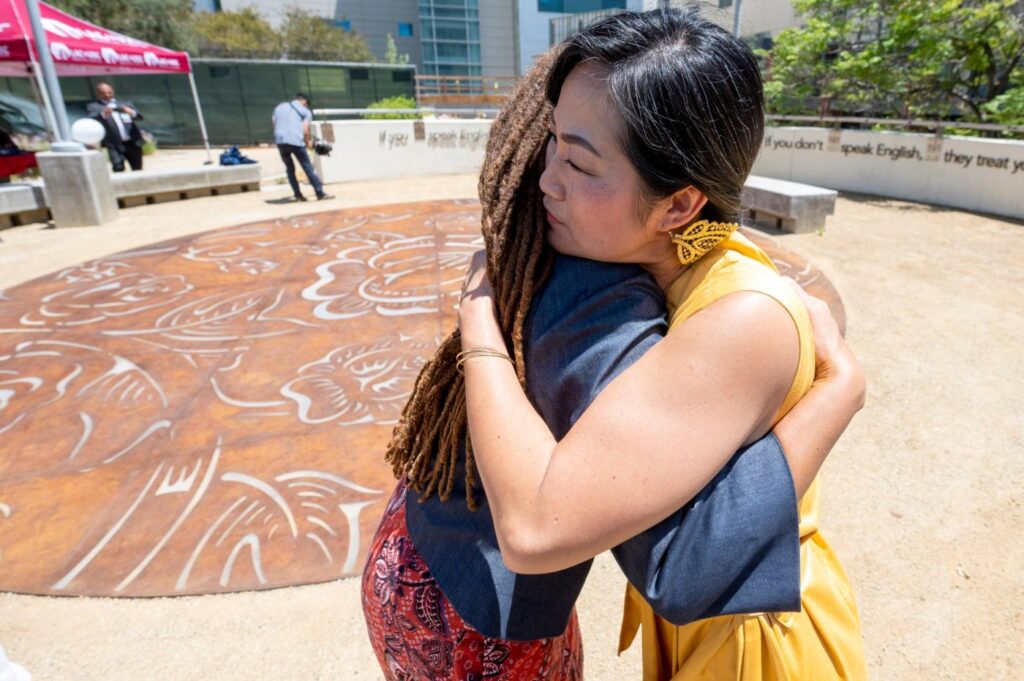
Black cloths were pulled away, uncovering the steel and concrete artwork beneath, and revealing the words from some of the 240 mostly Latina mothers forcibly sterilized at LAC + USC Medical Center more than 50 years ago: “If you speak English, they treat you one way. If you don’t speak English, they treat you another way.”
Their words are now set into curved walls that surround a steel floor sculpture engraved with flowers that symbolize fertility, and representations of Mexican leather artwork, all in honor of the resilience of hundreds of mothers who faced injustice and heartache decades ago.
During a somber unveiling ceremony Monday on a grassy courtyard at LAC + USC hospital, county officials gave the public the first look at “Sobrevivir,” an art installation by Cambodian-American artist Phung Huynh of Los Angeles in the works since 2018, ever since the county Board of Supervisors issued a motion containing an apology.
Meaning “to survive and to keep alive,” Huynh described her work, Sobrevivir, as a permanent apology and somber reminder of the coerced sterilizations performed on 240 mostly low-income, Mexican-American immigrant women. They delivered babies between 1968 and 1974 at the county hospital facility and then underwent postpartum sterilization, usually in the form of tubal ligation.
Investigations by the county raised serious questions as to whether the women understood what was being asked of them due to language and cultural barriers, and which concluded that the women’s consent may not have been informed.
First District Supervisor Hilda Solis, who spearheaded the project, said the story hit her hard, and years later is still relevant. “Many of the 240 women did not even realize until later they had lost their reproductive rights. This was an assault on their freedom, something we are seeing once again with the Supreme Court’s ruling to end the constitutional right to an abortion,” Solis said.
Women, community members, doctors, nurses, county officials and the press stood on the artwork’s edge taking pictures and videos of the large work and adjoining plaque. The moment “was a long time coming,” said Huynh in an interview before the ceremony.
“This is a haunting story,” she said at the end of her remarks. “And dark histories will continue to haunt us unless we do something about that. So this is the beginning of an effort to repair and heal.”
Such sterilizations began in California with a 1909 eugenics law that allowed doctors at state institutions to operate on people deemed unfit to have children. Often targeted were so-called “undesirable populations,” including the disabled, mentally ill, poor and people of color. More than 20,000 people — including some in their teens — were victimized before the law’s repeal in 1979.
Latina women were 59% more likely to be sterilized than non-Latina women, Solis said.
Jorge Orozco, CEO of LAC + USC Medical Center, said this is the first hospital to apologize for coerced sterilizations, even though many hospitals and other institutions performed the procedure.
Even after the law was repealed, an analysis by the Center for Investigative Reporting and a follow-up state audit found that more than 140 pregnant women, mostly Black and Latina, were given tubal ligations after giving birth at two California prisons between 2005 and 2013.
“This hospital has profoundly harmed our Latino community, a community it was meant to serve,” Orozco said. “This artwork will begin our healing process. It is an atonement for the serious harm we’ve caused and the need to rebuild community trust.”
Hospital Chaplain Elizabeth Gibbs Zehnder said absent Huynh’s work, the words of the mothers and their story would’ve been forgotten. “Their words are here for God and everyone to see,” she said.
Huynh is known for her exhibition of “donut kids,” in which she stenciled faces of shop owners and servers on bright pink donut boxes to illustrate the assimilation and cultural experiences of Cambodian and Vietnamese refugees who resettled in the U.S.
She said four different quilts, honoring the women who were sterilized, will soon will be installed somewhere inside the hospital.
LA County seeks reparations for 1968-1974 forced sterilizations at LAC+USC Med Center
Related Articles
‘Big Eyes’ artist Margaret Keane dies at her Napa home at 94
Sawdust Festival opens with flying monkeys, hand-crafted wine glasses, bamboo surfboards
At opening of The Cheech, Latino culture claims the spotlight
Cheech Marin museum opens to cheers, cultural celebration in Riverside
Photos show inside Cheech Marin’s new museum in Riverside
